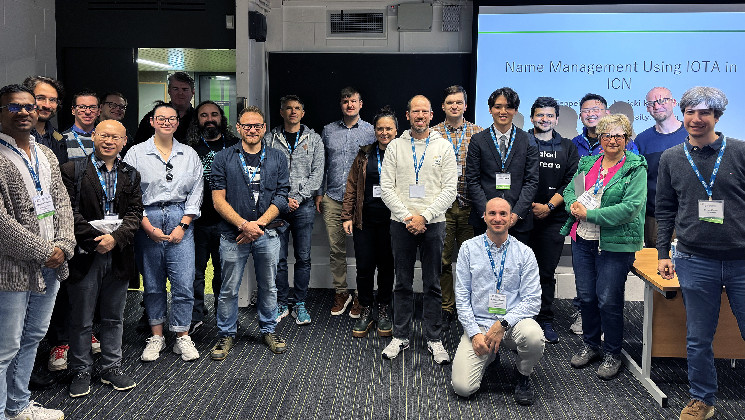Insights from the 2nd International Workshop on DAG-based Distributed Ledgers
TL;DR:
The Beyond the Chain workshop on May 31, 2024, at Trinity College Dublin explored how DAG technology can overcome blockchain limitations. Shai Wyborski’s keynote emphasized DAG’s efficiency and scalability benefits over traditional blockchains. Presentations covered topics like secure IoT data transmission, shared objects in Sui smart contracts, name management using IOTA, and a study on DAG-based consensus protocols.

Participants at Beyond the Chain 2024
Solving the limitations of traditional blockchain with Directed Acyclic Graph (DAG) technology is the focus of Beyond the Chain: Workshop on DAG-based Distributed Ledger Technologies. Featuring contributions by several IOTA Foundation members, this year’s edition was held on Friday 31st of May, 2024 at Trinity College Dublin as part of the IEEE International Conference on Blockchain and Cryptocurrency, which ran from 27 May 2024 to 31 May 2024.
Despite taking place on the last day of the IEEE Conference, our workshop attracted a good crowd with surprisingly few signs of conference fatigue! The session was kicked off with a keynote by Shai Wyborski, a researcher at Kaspa, a PoW- and DAG-based distributed ledger technology. Shai’s keynote was followed by four presentations based on papers written for the conference: we’ll present the abstracts of these papers after a quick recap of Shai’s keynote.
From Blockchain to DAG
In his keynote, Shai highlighted the critical need to transition from traditional blockchains to DAG structures, addressing the inherent limitations of blockchains regarding efficiency and scalability. Blockchains suffer from high orphan rates and reduced parallelism, undermining their performance.
In DAG-based distributed ledgers – or “blockDAGs” –, each block can reference multiple previous blocks, creating a more complex but efficient DAG structure. Shai provided an insightful overview of various blockDAG implementations like SPECTRE, Tangle, and GHOSTDAG. These systems achieve scalable and secure consensus through topological sorting. He also explored the need for parameterless protocols like DAGKnight, which adapt dynamically to network conditions without predefined parameters, improving confirmation times and network performance.
Looking ahead, he emphasized the importance of creating rational miner incentives to maintain protocol integrity, exploring new models for fee markets within DAG structures, and addressing scalability through innovative consensus mechanisms.
The keynote concluded with a lively discussion between Shai and the audience. The exchanges reflected a shared belief that these advancements could propel blockDAGs, and DLTs in general, to new heights.
Interactive Sessions
Following the keynote, the conference featured four interactive sessions that were based on research papers submitted to the workshop.
Secure Transmission of Immutable Data for Low-Power, Long-Range Wireless IoT Services
In the first session, Andreas Baumgartner from Chemnitz University of Technology discussed his paper co-written with his colleagues Nada Akkari, Sudip Barua, and Thomas Bauschert: “Secure Transmission of Immutable Data for low-power, long-range Wireless IoT Services”.
A Study on Shared Objects in Sui Smart Contracts
Shared objects – data structures that multiple transactions or smart contracts can access and modify concurrently – were the focus of the next presentation, by IOTA Foundation’s Roman Overko.
Name Management Using IOTA
Teppei Okada from Ritsumeikan University, Japan, presented his paper written with Noriaki Kamiyama (also from Ritsumeikan University), “Name Management Using IOTA”.
Systematization of Knowledge: DAG-based Consensus Protocols
Finally, Mayank Raikwar (University of Oslo) and the IOTA Foundation’s Nikita Polyanskii and Sebastian Mueller provided a comprehensive overview of DAG-based consensus protocols.
See You Next Year?

